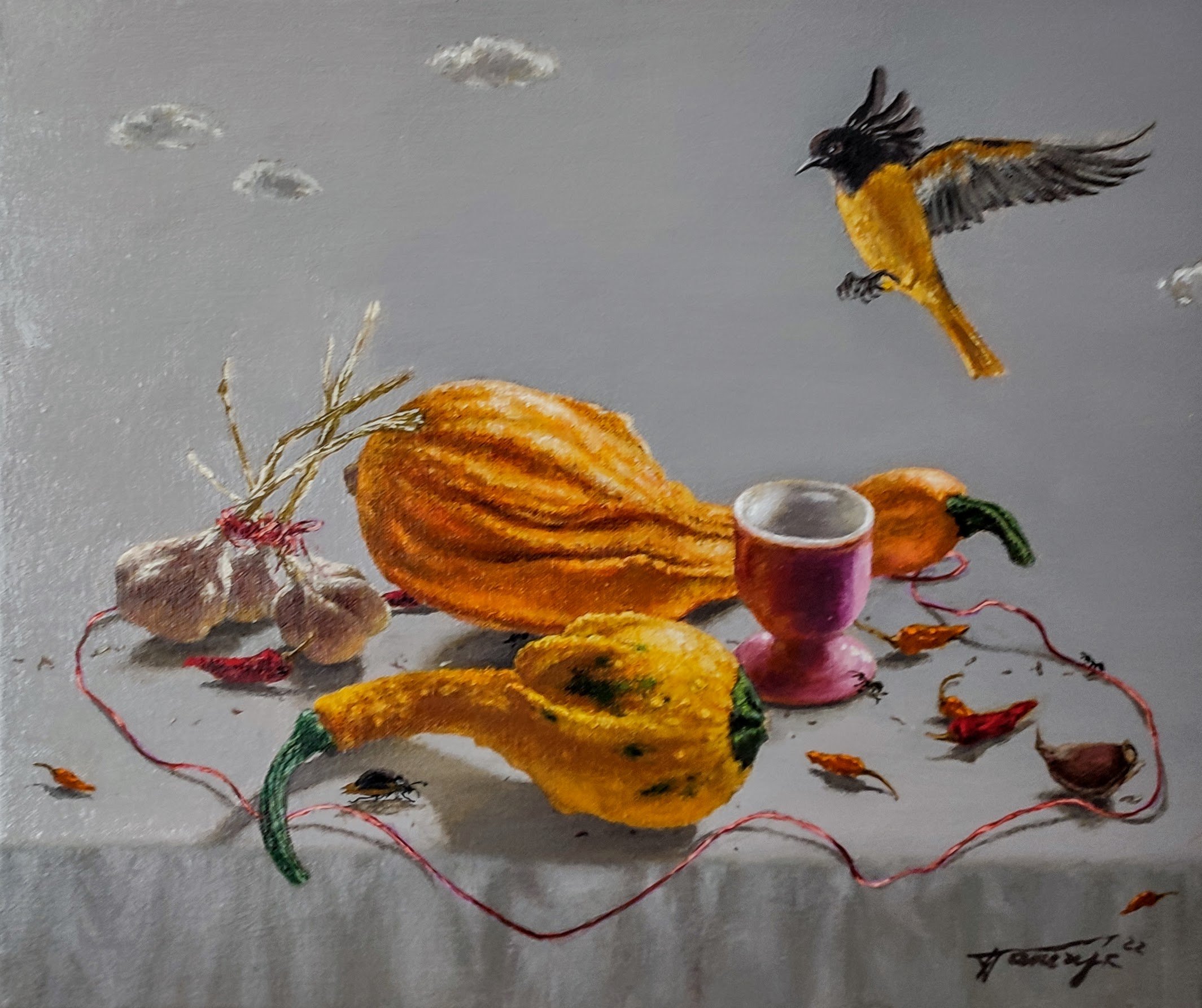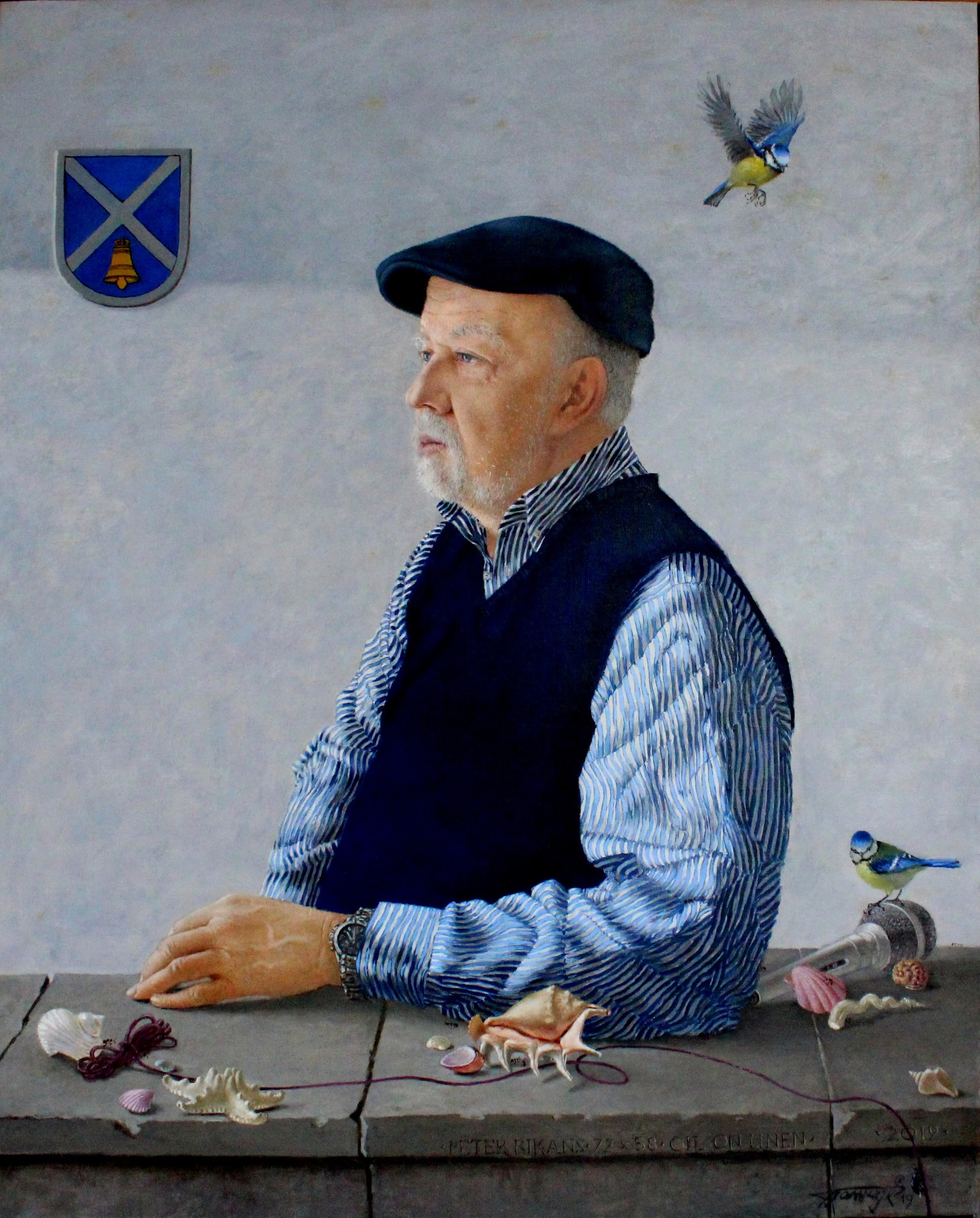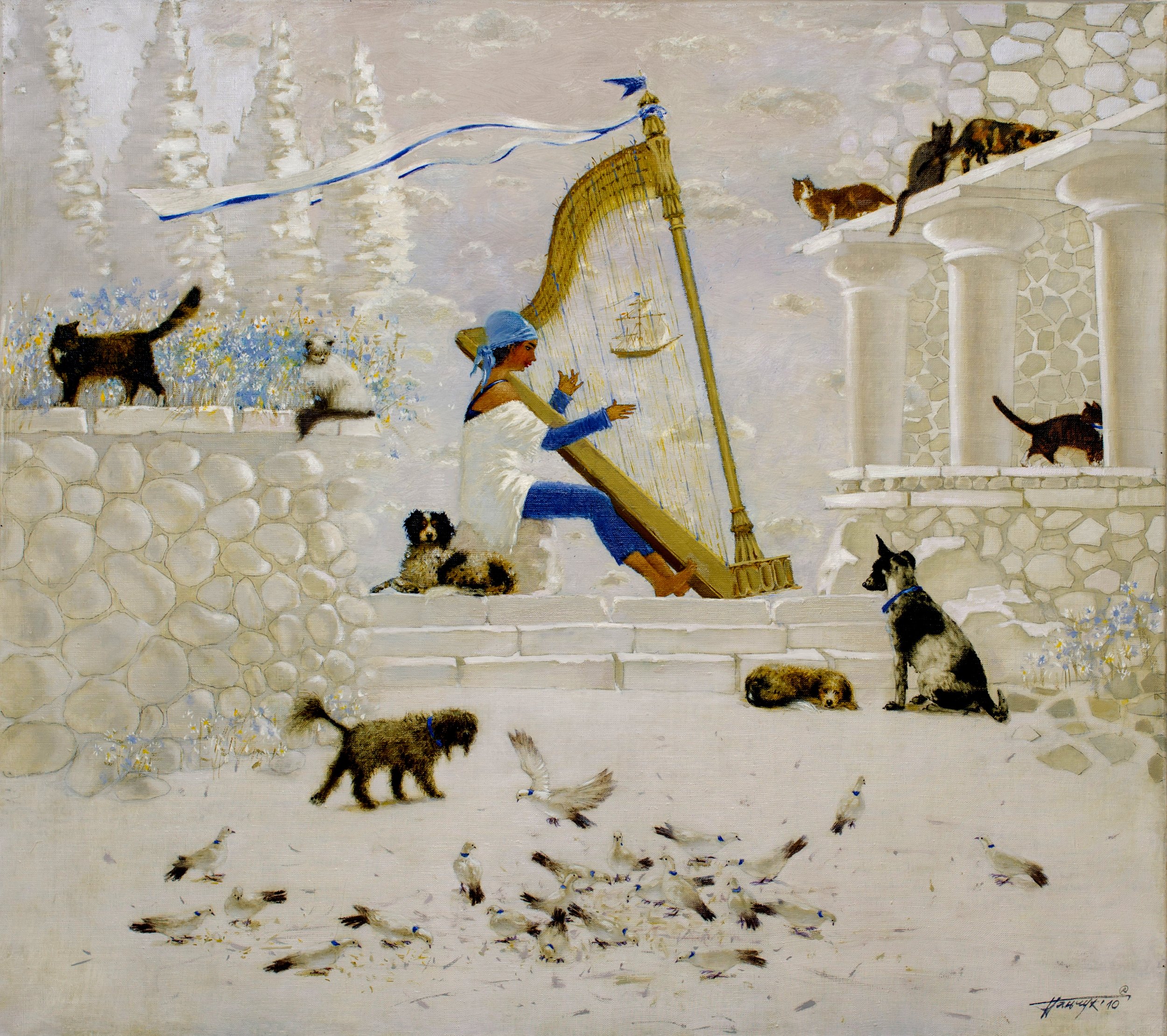Tatyana Palchuk
The European – Baltic Artist Tatyana Palchuk.
Tatyana Palchuk was born in 1954 and lived all her life in Riga, in a small area between the Art Academy and Elizabeth Street. Already during kindergarten, teachers predicted the little drawer an artist's destiny. Although nobody was connected to arts in the family, she was constantly drawing in the sand with a stick in hands. Tatyana lost her relatives in soviets Stalins represions ( She have Ukrainian Dona’s Kozaks , Russian ,Hebrew roots) , and father at an early age and has been growing independently as other 50ies - 60ies kids, and she was the eternal engine and captain of the yard kids. Tatyana enrolled Rozentals Art School by herself even not informing her mum. The artist tells that becoming an artist was not as easy as pie for her, and she had drawn on to the level of the more talented school and academy members, in her opinion, only by thorough and accurate work. Her teachers are indisputable stars of Latvia and Europe Art - Imants Vecozols, Pēteris Postažs, Boriss Bērziņš, Edgars Iltners and academic Eduards Kalniņš. She has been among the few who have done the postgraduate course or workshop with the academic Eduards Kalniņš.
Tatyana is proud to have had the honour and uncommon confidence to visit and grow artistically at the academic's home, and studio and have him at her small studio of only 12m2 in the Elizabeth Street apartment. The experience and know-how given by these art Grands have been invaluable and it has helped Tatyana to grow the one and only art figure, she has become. Tatyana has been living quite a secluded self-centered life of an artist. Therefore she can't be spotted at any parties, exhibitions and other events so typical in the world of arts. Tatyana doesn't attend contemporary art exhibitions and she finds her inspiration going to Europe culture centres rejoicing in Renaissance, Hollandaise, Italian and other world treasure artworks at famous galleries and museums. One of her favourite art museums is Gemäldegalerie in Berlin, which she visits yearly. Tatyana's motto is that anything new hasn't been invented but it has already existed, a Human is only a small part of macrocosm breathing harmoniously around us with microcosm inside itself, which is possibly as infinite. She is to no extent affected by the modern trends and loud attempts to draw attention to onself. The main characteristics of her works are positivism, humanism and harmony with the united world. They have been drawn in an excellent painting technique and mixing modern and ancient - a manner characteristic only for this artist. No doubt it is psychologically a quite tricky road, always to be a bit of a stranger among peers. But there are a great many Tatyana's art admirers scattered all around the world. Her works are in collections in many world countries, likewise in repositories of the Russian Art Union and Ministry of Culture of the Russian Federation. During the peak years of creativity, Tatyana had excellent success at international competitions and art markets ( sells in Top 15, Ravenel Auction House). Last year's significant exhibitions was participation at international painting exhibitions in New York, Rome , Palermo , Antwerpen, Spain, Denmark , Germany , Taiwan , Czech Republic and other world art centres.
Please tell us more about your background and how you began creating art?
I was born in Riga, the capital of one of the Baltic States - Latvia, in 1954, in a very simple family, which was not related to art in any way. In such an ordinary family of servants. Father, a Soviet soldier who was seriously injured in the battles for Riga during the Second World War and after being hospitalized, he stayed in Riga as a war invalid and died a few years later at the age of 49. Now, looking back in history, I am the daughter of the occupiers of the war (I really understood that when Latvia got free from the occupation of the Russian Communist Empire in the 90s). It was an unpleasantly bitter experience when the peoples of the occupied nations could say it out loud. I love my country Latvia all my life and I am its patriot. Such is life in this turbulent world, and it still continues, despite cataclysms and clashes of civilizations. It's a pity that people don't learn from past mistakes anyway.
It was very difficult for my mother , after Dad dead , to raise me and my older sister alone in the poor post-war years. The main thing was to feed the children, in fact, my mother almost didn't have many other things and the opportunity to pay more, but there were always books and a piano in our house and my mother found a way to pay for music lessons with a piano teacher. It was my mother's will, not our, naughty girls' wishes. But it was my music teacher Mrs. Karina Weber was the one who inspired me not only to hear music, but to feel it physically and see - visualize its images, and get real pleasure from good music. Music is still a serious and very important basic element in my painting. My older sister was a real educator for me. It was she who followed what I read every day, took me to the cinema, sewed my clothes herself, taught me what is good and what is bad.
If you can say that, then I had a happy childhood, I felt that way, and I was not aware of poverty and deprivation. Like many children, I also really liked to draw. Kindergarten teachers said: "Tanya will definitely be an artist". And it happened. At the age of 10, I submitted my documents to the Jan Rosenthal Art School and, miraculously, I was accepted. From the 5th grade I started to learn my life profession. After 7 years in "Rosentals", after 3 probe steps, I entered the Latvian Academy of Arts, Faculty of Painting. Then 6 years at the Academy, another 3 years of Postgraduate studies at the USSR Academy under Academician Eduards Kalniņš. ( 1. Master's Degree) . I defended the second Master of Arts in 2003, again in free Latvia. I had the good fortune to learn from indisputable stars of European and World level Baltic Art who generously shared their knowledge and experience. It was a great happiness. But I still continue to learn from the old Grand Masters of Europe and the World, and above all from nature and the grand world around us, in which we are a small part of everything.
What does your art aim to say to the viewers? Do you have an essential philosophy that guides you in your creative expression?
The philosophy of my beliefs and their system is simple. Our Planet with its living and non-living nature and people who are gifted with intelligence is a wonderful phenomenon.
All together we are a part of the Macrocosm. In nature, everything is interconnected, harmonious, ingeniously reasonable and, therefore, absolutely beautiful in the fullest sense of the word. There is neither evil nor good in nature. It just is. It's different with people. They have been given the understanding to judge what is good and what is bad.A person is able to act both wonderfully and repulsively evil and understand and appreciate it.
And....since we haven't destroyed each other yet, then there is more good and love on Earth than evil. And it's wonderful!!!
And these thoughts are exactly what I want to convey to my viewers with my paintings. Through them I share my understanding of the world and our life.
What art marketing activity do you put into practice regularly that works most successfully for you?
I'm going to take a step back here, and immediately explain why. Theoretically, I know a little bit about art marketing issues, but in practice I am not able to apply this understanding. It (marketing) takes too much energy and time, because it is another, really difficult and serious job. Then I would have neither time nor energy for my main activity, creativity - painting.
I am lucky, my husband Peter Rikans is the one who deals with marketing work. This is the second marriage for both of us. We got married already at a serious, middle-aged age (both around 50). Until we met, he was a great lover of art, well versed in it and a collector. In his youth, he wanted to become a painter, but due to various circumstances, it remained unrealized. Now that we are together, he loves this marketing and promoter work, and it is very important for a good result.
Peter decides about participating in what competitions, painting auctions and exhibitions and works with clients and partners. He says, I have for the competitive market has some drawbacks:
a.) I am from a small, world-quiet country that only 30 years ago got rid of the occupation of the Soviet Russian Empire after the Second World War.
Although from Homeland Latvia there are such stars as Mark Rothko, Andrejs Nelsons, Serge Eisenstein, Mariss Jansons, Misha Maisky, Baryshnikov and many others...
b.) I am a woman (the world art market is still dominated by men)
c.) I'm still alive (sad humor)
And we both laugh, because these are still significant flaws, yes seriously.
Can you tell us about the process of creating your work? What is your daily routine when working?
Oh, this is a multi-step process. First, of course, there is an impulse, an idea,
It may be something I saw that made a big impression on me. For example, Rays of Light on autumn leaves, Snow Fall, the graphic beauty of a tree, interesting clothes, a situation, an interesting face, an animal, a bird, or exciting music.
Oh, and the works of the old Grand Masters. Especially Italian Proto-Renaissance, Northern Renaissance, International Gothic, etc... For me, the first impression, the first feelings, what I get from everything around us is very important. It is also a artwork birth impulse,beauty, the beauty of feelings and positive impulses. As American Art Historian, Art Scientist Bernard Berenson said: "Not what man knows but what man feels, concerns Art".
Well, the next stage is the practical work. Drafts, sketches, etudes, both with pencil and with colors. Searching for the best composition that could represent the images and feelings of my first impressions. Good composition - in my opinion, the main element of a good painting. It is in the search for a composition that the artist's professionalism is needed. But, let's go further, so that this doesn't turn out to be a small lecture for beginners in the field of art.
Next, I draw the full drawing-cardboard of the next painting, 1 versus 1 as in the next painting. This is what the old masters of the Italian Renaissance did for their frescoes, in order to transfer the drawings to the walls afterwards. Why do I do it? It helps to polish the finished composition and see how it will look in the finished work.
These first stages of the creation process are the longest and most difficult, because this is the search for the best solution. Then, Copying the graphic work onto the canvas. Once this is done, all that remains is to paint the painting with oil on linen.
I paint with colors only in natural light, in the workshop by the window. It is neither good nor bad. I'm just used to it. Therefore, working with color for me depends on the length of the daylight hours. Sometimes it is not really convenient, but habit is a very strong argument. However, I draw without restrictions, also in artificial lighting.
How much planning goes into each artwork?
In the previous answer, I explained in detail how the idea is realized in the finished Painting. An impulse, an idea, a thought comes instantly, but it takes a lot of time for me to see in my head (imagination) how to better show what I have imagined. In order not to forget the ideas, I write them down briefly on paper. This was recommended to me by one of my teachers at the Art Academy, Professor Edgar Iltners. Sometimes the idea of a painting comes in a completely inappropriate place and situation, on a bus, at a concert, on a walk, etc... Or ideas come suddenly, one follows the other, like a stream. And there is neither time nor opportunity to draw-sketch. Then a few quickly written words, a sentence, a descriptive phrase help well. I always have paper and a writing tool in my purse or pocket. That's is it, and that's it. So the idea is "caught", fixed and I will never lose it again. If the idea of the painting is clear "in the head", then the technical process for one painting can take one, two or three months. Of course, it depends on the size and complexity of the painting. For example Portrait, Landscape, Still life, Figural composition. And more. I always only paint one painting at a time. I cannot start a new job without finishing the previous one. All my attention and energy belongs to the painting I am painting at that moment. This is my individual habit, not being able to divide myself for several jobs at the same time.
When the work is finished, I need time to free myself, relax for new work and tension. I feel like a student who has just passed the exam session. Feeling so drained and a bit distracted. Need some time, do nothing.
What’s the essential element in your art?
It is important for me to convey to people the thoughts, emotions and feelings that I had at the moment when the idea of a new painting arose. Impulse from seeing something wonderful, catharsis created by music, from everything around us. To convey the pleasure of beauty that is all around and is in everything, big and small. From the flight of the bumblebee to the infinity of Space.
In your opinion, what role does the artist have in society?
As long as the artist does not show his works publicly, does not participate in exhibitions, he has no influence on the society. But as soon as he exhibits his art in the public space, of course he immediately publicly demonstrates his position in life, his attitude towards society and his philosophy. It is a kind of dialogue with the viewer through his art. And the topics of the dialogue can be very different. From political slogans to showcasing the dirty side of life. I don't know what the result of my dialogue with the audience is. He is simple, sincere and kind. I really hope it's positive.
In my paintings, I share the beauty of the world around me, as I see and feel it.
This is my role as an artist in the eternal theater of life.
Are there any projects you are currently working on and able to speak about?
I am currently working on a series of paintings called 'Stroll'. These are landscapes in which nature is depicted in all seasons. In all works there are people, birds, dogs, riders. What I like very much and is beautiful. In my opinion, there is nothing more beautiful than the world created by the Creator , and a man, as a part of everything, in it. With all that people have created over the centuries and, I really hope, will not themselves destroy .
Because the good and the beautiful always win in the end.

















